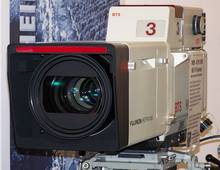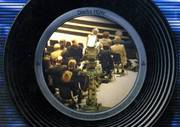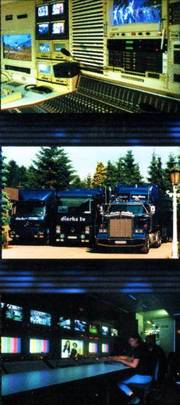Wie denken wir in 2008 über analoges HDTV aus 1988 bis 1993 ?
1996 - Eine Zusammenfassung und ein Rückblick auf analoges 1250 HDTV in Europa in den frühen 1990ern.
Am Ende der 1980er wurde in Europa das "Eureka 95 Projekt" von der EU, den Sendern und einigen wichtigen Herstellern wie BTS und Thomson gestarted, ein europäisches HDTV System - als Gegenstück zu der japanischen Entwicklung - auf die Beine zustellen.
Die Initiative basierte auf:
- a) analogen Übertragungsstandards (HD-MAC for HD-TV, D2-MAC for SD-TV = Standard Definition-TV),
- b) Test-Produktionen & Testsendungen während der Olympischen Spiele 1992 in Albertville und Barcelona und
- c) zahllosen Produktionen in Europa, organisiert von dem European Consortium "VISION 1250", wobei die Geräte und Einrichtungen überwiegend von Thomson und der BTS geliefert werden sollten.
.
Anmerkung: In dem Artikel wurden die 500 Millionen Mark Fördergelder der EU nicht erwähnt - warum nicht ? Bezahlt wurde das Forschungs-Projekt nämlich aus üppigen EU Steuergeldern, nicht alleine von den Herstellern oder den Runfunkanstalten oder den Sendern. Und den jeweiligen 50% Eigen-Anteil der Industrie konnte man über großzügigste (man nennt das auch kreative) Kalkulationen der Gemeinkosten weit ausdehnen und schon stimmte die Rechnung wieder. Für dieses "Fundraising" bei der Fese/BTS war Professor Hausdörfer zuständig - und er hat viel davon erzählt.
.
The Olympic Winter Games at Albertville, France in 1992, was the first big sports event in Europe that was produced and transmitted in HDTV-in parallel to the standard coverage in PAL and NTSC.
The European Consortium VISION 1250 was responsible for the production and distribution of the HDTV programs produced at the Olympic venues in France. Transmission of the signals at the time were provided via Satellite using the analogue HDMAC-transmission standard, reception was provided at about 150 special viewing sites throughout Europe.
European production teams from France (SFP), Italy (RAI), England (BBC), Sweden (SVT), Spain (RTVE) and Portugal (RTP) produced the individual events. BTS (Broadcast Television Systems GmbH) from Germany - at that time a joint venture company of Bosch and Philips - and Thomson Broadcast from France provided the production infrastructure.
Thomson later took over BTS and is today a major supplier of broadcast equipment under the brand name Thomson Grass Valley.
In the beginning of the 1990s both companies manufactured HDTV OB Vans and facilities to provide editing and master control capabilities to provide the broadcast infrastructure for the Winter Olympics 1992 in Albertville, France and the Summer Olympics 1992 in Barcelona, Spain.
The BTS production infrastructure
Die BTS Productions Einrichtungen enthielten :
- zwei HD Ü-Wagen mit 6 Kameras (Satelzüge), each equipped with
• 6 x KCH 1000 HDTV Cameras, triax connection
• Vision Mixer RMH 1000
• 3 x BCH 1000 HDTV Videorecorder
- ein HD Ü-Wagen mit 4 Kameras, equipped with
• 4x KCH 1000 HDTV Cameras, triax connection
• Vision Mixer RMH 1000
• 2 x BCH 1000 HDTV Videorecorder
- zwei HD Ü-Wagen mit 2 Kameras, each equipped with
• 2 x LDK 9000 HDTV CCD Cameras, fiber connection
• Vision Mixer RMH 1000
• 3 x BCH 1000 HDTV Videorecorder
- One Edit-Van, equipped with
• 3 x BCH 1000 HDTV Videorecorder für Post Production
• linked with
- Two Slow Motion Units, equipped with
• HDDR 8000 (High Definition Disk Recorder),
• Capable of recording up to 103 seconds of digital, full resolution HDTV material
- One Master Control Unit (MCU), equipped with
• 2x Vision Mixer RMH 1000
• 2x character generators
• for program creation from all venues (directly connected or tape-based)
• 6-channel audio to generate stereo sound plus 4 multi-language commentary channels
- One 2-Camera Studio with adjacent commentary facilities, equipped with
• 2x KCH 1000 HDTV Cameras, triax connection
• 2 x BCH 1000 HDTV Videorecorder
• Vision Mixer RMH 1000
• 3 x BCH 1000 HDTV Videorecorder Pool for recording
• Commentary facilities with HDTV monitors
All systems were using analogue component technology
The 6-Camera HD OB Vans were used to produce the major events in Albertville such as the opening ceremony, speed skating, figure skating, ice hockey and the closing ceremony.
The 2-Camera vans were used together with the 6-Camera vans in Albertville but also for events in other Olympic venues such as Biathlon, Ski Jumping, free style skiing, and alpine ski events.
The Edit facility and the MCU were positioned at the HDTV IBC at Albertville.
The Thomson (EX CAMERA) production infrastructure
Thomson Broadcast, through its facility company EX CAMERA provided also a similar number of OB Vans and edit facilities:
- Two 6-Camera H DOB Vans, each equipped with
• 6xTTV-Series HDTV Cameras
• Vision Mixer Synonyme-family
• Recording with Dual-DiVTR's
- One i-Camera HD OB Van, equipped with
• TTV-Series HDTV Camera
• Vision Mixer Synonyme-family
• Recording with Dual-DiVTR's
- One Edit Van, equipped with
• Dual-DiVTR's
- One HD-MAC encoding van
These facilities were also used during the Summer Olympics 1992 at Barcelona to cover the sport events in a similar fashion. In addition to the Olympic Games the mobile production units of both companies were used to produce numerous HDTV programs all over Europe, later managed by the European Consortium VISION 1250, including events such as
- - The celebrations for the 200-year anniversary of the French Revolution in Paris, 1989
- - Circus Knie, Switzerland
- - The visit of president Gorbatschov in Germany
- - BTS promotional production "People"
- - The Winter Olympics 1994 in Lillehammer
- - The Summer Olympics 1996 in Atlanta
-
Insgesamt wurden nur ca. 50 Produktionen in HDTV gefahren
All together some 50 productions were accomplished until 1996.
- Das HDO (High Definition Zentrum Oberhausen) ging bereits 1990 bis 1994 mehrfach pleite.
.
After 1996 the EUREKA project was stopped, . . .
. . . . because the 1250 system failed to get market acceptance due to the following reasons:
- a) Picture quality of the analogue transmission was not good enough,
- b) insufficient resolution of the receiver displays,
- c) the 16:9 aspect ratio still was conceived as "exotic" and
- d) large displays were too expensive and too heavy (only CRTs were available).
Nevertheless it was the start of the emerging drive for the 16:9 aspect ratio TV displays which today are dominating our living rooms.
.




